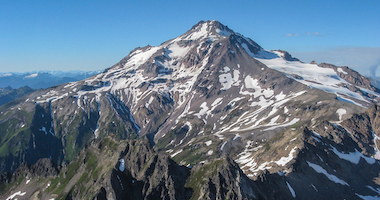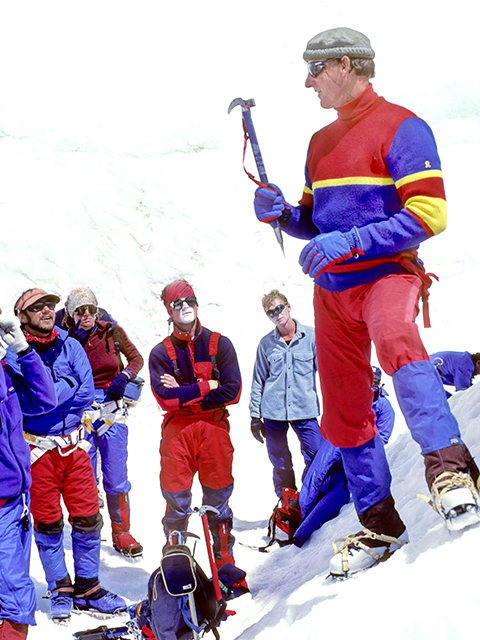Most Popular Entries
Posted by: Jake Beren, Camille Leininger, Leif Bergstrom
Categories: Expedition Dispatches Mount Rainier
Elevation: 14,410'
The Mt. Rainier Summit Climb team reached the summit this morning just after 7 am. The team, led by RMI Guide Jake Beren, experienced beautiful weather with sun above the cloud deck that was settled around 7,500'.
Congratulations to the team!
Posted by: Kiira Antenucci, Emma Lyddan, Mira Schoeberlein
Categories: Expedition Dispatches Mount Rainier
Elevation: 14,410'



The All-Women’s Climb led by RMI Guide Kirra Antenucci reached the summit of Mt. Rainier on a clear and beautiful day. The team took on all the challenges the Disappointment Cleaver route has to offer in the late summer and stood on the summit at 7:15 am.
Congratulations Team!
Posted by:
Categories: Mountaineering Fitness & Training

High Intensity Interval Training, often referred to popularly as HIIT training, have been featured in a few recent studies that concluded that a short HIIT workout was as or more effective at promoting cardiovascular health than steady state activity. The first paragraph of a recent New York Times article reads:
Think you’re too busy to work out? We have the workout for you. In minutes, high-intensity interval training (HIIT) will have you sweating, breathing hard and maximizing the health benefits of exercise without the time commitment. Best of all, it’s scientifically proven to work.
Despite the recent attention, interval training is not anything new to seasoned athletes and coaches who have understood the benefits of repetitive high intensity workouts for a long time. Many of the recent studies have focused on previously sedentary people trying to improve basic cardiovascular health, rather than on elite athletes striving towards a performance goal. With that said, we have and continue to encourage climbers to utilize interval training (by it’s nature high intensity) as part of a well-designed training program.
Interval training can accomplish a wide array of tasks and works best when the focus of a workout is clear:
Longer intervals, from 5 to 8 minutes, at 70 – 85% of max heart rate work to improve the lactate threshold, the body’s ability to metabolize and clear lactate build up from muscle cells, increasing the amount of work that the body can perform sustainably. A good example is an elite level marathon runner, who is able to sub six-minute miles for over two hours during a race. The intensity that they are working at is very high, yet the body is able to sustain it over a very prolonged period of time.
Shorter intervals, from 20 seconds to a few minutes, performed at 85 – 95% of max heart rate (very intense!) increase the body’s anaerobic threshold, it’s ability to perform work while in oxygen deficit. Think Olympic swimmer in the 50-meter butterfly: the intensity that they race at surpasses the body’s ability to clear lactic acid and to provide enough oxygen to the muscle cells for them to continue that pace for a long period of time. The race is very short, however, and for that 20-something seconds, their muscles are able to put out an immense amount of power in oxygen deficit.
It may seem as though interval training isn’t as applicable to our sport of mountaineering. We tend not to sustain the very high levels of output, but instead operate for far longer periods at moderate intensity. It is the very definition of an endurance sport. Interval training provides other physiological adaptations however that go beyond the abilities of the skeletal muscles. Interval training is shown to increase cardiac output, by increasing the size of the left ventricle, the stroke volume and the overall contractility of the heart. Increased cardiac output supplies more blood to muscle cells, delivering more oxygen and removing more waste. Additionally, interval training has been shown to increase the size and density of mitochondria in the muscle cells. Mitochondria use oxygen to convert glucose to ATP (the cells’ energy source). Both of these adaptations help endurance athletes go longer, faster and with less effort, and ultimately help us in the mountains.
Interval training is harder on your body than traditional steady state workouts and requires longer to recover from as well. Therefore, too heavy of a focus on interval training can lead to overtraining and injury. More of a good thing isn’t necessarily better. It’s important to realize that a good training plan maintains a balance of high intensity workouts and lower intensity steady state workouts.
As part of the recent HIIT hype, people have championed the fact that HIIT gets more done in less time, even as little as 10 minutes. This may be true for an average person whose goal is to improve overall cardiac health, but for athletes working towards goals in the mountains, remember that there are no short cuts. Time invested in your training will lead to a more enjoyable and successful climb.
_____
Questions? Comments? Share your thoughts here!
Fantastic insights on integrating HIIT into rock climbing training! Your clear explanations make it effortless for novices like me to recognize the benefits. Thank you!
Posted by: Musclegaragefitness on 12/29/2023 at 4:15 am
Incorporating HIIT into mountain climbing education is a game-changer! Your insights supply a realistic method to elevating health for difficult terrains. Thanks for the treasured guidance!
Posted by: Rejesh raj on 12/18/2023 at 1:29 am
RMI Guide Elias de Andres Martos checks in from high camp on Alpamayo.
We just got word that you successfully summited! Way to go team. We are in awe of this magical experience. Can’t wait to celebrate over Face-time with you. Now focus on getting down safely.
Posted by: Rhea Campbell & Alex Lickerman on 7/24/2014 at 10:05 am
Posted by: Alex Van Steen
Categories: Expedition Dispatches Carstensz Pyramid



I have seen the above comments that others has given and read the comments that describes about Carstensz Pyramid Expedition. I congrats you for proving the such a wonderful information.
Posted by: Climb Carstensz Pyramid on 5/16/2014 at 4:26 am
Posted by: Adam Knoff, Hannah Smith
Categories: Expedition Dispatches Everest BC Trek and Lobuche


Day 16-17
Waking into Namche this round through was much different than the first time. Despite our sizable group, we were by no means the largest on the trail.
This place is now in full swing with Everest climbers, international trekking teams and yak trains going up the valley towards Everest Base Camp.
Even though the traffic resembled more of a US interstate than a single-track trail, we were pleased to land back at camp de base where we were welcomed with hot showers, Nepal Ice “extra strong beer” and the comforts of nice rooms with personal bathrooms. The hike was roughly 8 miles from Pangboche consisting of many ups and downs but nothing the seasoned team couldn’t handle.
After a normal 7:30 breakfast the following morning, we set our sights on Lukla, home of the infamous dead-end runway and gateway to Everest. Eleven miles and 6 hours after leaving Namche we strolled in with time to spare before dinner so naps all around became the team activity. The clouds were thick as pea soup by 7 pm so our flight status was a bit unknown. With fingers crossed we went to bed. When our alarms ripped us awake at 5 am the disheartening presence of this fog was still lingering out the window.
We made our way anyhow, walking to the airport to check in and hope for the best. After waiting for ten hours to fly on the way in, we were not hoping for a repeat. Two hours in we were beginning to get a bit worried and then the first plane landed. Ten minutes later we were loaded up and, in our way, back to Kathmandu!
Now we are clean, fed and content, celebrating a fun and successful trip. I can’t thank this team enough for a great few weeks in Nepal.
This wraps up the Everest Base Camp and Lobuche expedition. Thanks for following!
RMI Guides Adam Knoff and Hannah Smith and Team
Amazing trip. Would do it all over again. This trip changed the trajectory of my life. Thank you for your expertise guidance and comeraderie
Posted by: Eva on 4/9/2022 at 3:17 am
Congratulations! If you are in southwest Idaho, look us up!
Posted by: Molly Knoff Vaughn on 4/8/2022 at 10:01 am
Posted by: Mike King, Taylor Bickford, Henry Coppolillo, Cal Smith, Axel Ryd, Lauren Macklin
Categories: Expedition Dispatches Mount Rainier
Elevation: 11,200'
Due to overhead hazards, the Mt. Rainier Summit Climb, led by RMI Guides Mike King and Taylor Bickford, turned at Ingraham Flats. They reported smoky skies and a busy route. After packing up at Camp Muir, the team began their descent to Paradise at 9:00 a.m.
On The Map
Missing you so much, but looking forwars to many stories and memories. Take lots of pictures and give stuff away. We just want you back i one good healthy peice! I love you so much and cant wait to have you in my arms again! I miss you touch and your smell!
Always and Forever! Deb
Posted by: Deb McLaughlin on 4/2/2011 at 3:46 am
WOW! Tim you rock! We’ve been looking at the pictures—what an amazing adventure. Stay safe, have fun, feel the place, and be prepared to come home and tell us every detail. We are living the dream, vicariously, through you! MaryLou
Posted by: MaryLou Bailey on 4/1/2011 at 10:08 am
Posted by:
Categories: Mountaineering Fitness & Training
| DAY | WORKOUT | TOTAL TIME | DIFFICULTY |
| 1 | Rainier Dozen / Easy Hiking ( 30 min) | 42 min. | Medium |
| 2 | 1-2-3 Stair Workout x 4 | 72 min. | Very Hard |
| 3 | Rainier Dozen / Rest | 12 min. | Recovery |
| 4 | Rainier Dozen / High Intensity Stair Interval Training (50 min) | 62 min. | Very Hard |
| 5 | Rainier Dozen / Rest | 12 min. | Recovery |
| 6 | Rainier Dozen / Cross Training | 60 min. | Medium |
| 7 | Rainier Dozen / Hike (6 hrs, 15 pounds of pack weight) | 372 min. | Medium |
| Total | 10 hrs 32 mins |
Posted by: Adam Knoff, Hannah Smith
Categories: Expedition Dispatches Everest BC Trek and Lobuche
Elevation: 17,575'

Today was not unlike most of our others the last week. Breakfast, packing then walking. Except today we would finally reach Everest Base Camp. It is almost agonizing to see the bright yellow tents in the distance and feel like they are not getting any closer. But three hours of steady walking landed the entire team safely at the Base Camp rock. We were greeted upon arrival by our gracious Base Camp Staff with cookies and hot tea. The views of the Khumbu icefall, Mt. Everest and Nupste were incredible the entire morning. After our entrance greeting, we hiked the final 30 minutes to our camp site and enjoyed hot showers, a great dinner and interesting sounds of far off avalanches.
Everyone is now tucked into their cozy tents ready for a good nights rest. We will report tomorrow after our hike back to Lobuche.
Hey Hannah and Adam!!!
This is So Cool!!!
Farmer Dave
Posted by: Dave Kestel on 4/2/2022 at 11:12 am
Congrats on hike well done! Glad weather is your blessing. Best returning.
Posted by: Jane on 3/31/2022 at 12:05 pm























Congratulation Jake + Team, Walter
Posted by: Waltero Glover on 8/28/2021 at 3:31 am
Way to go! One day!
Posted by: Bryan Lundgaard on 8/28/2021 at 3:24 am
View All Comments